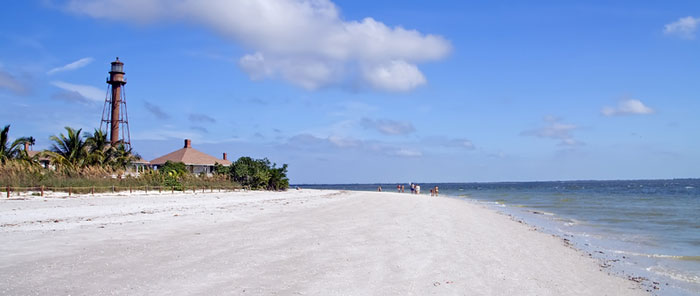Sanibel Island
Sanibel Island •
Captiva Island •
North Captiva Island •
Cayo Costa
Cabbage Key •
Useppa Island •
Boca Grande
Sanibel is a city in Lee County, Florida, United States, on Sanibel Island. As of 2006, the population recorded by the U.S. Census Bureau is 6,066.[2]
The main town is at the eastern end of the island, while the community of Santiva (a portmanteau of Sanibel and Captiva) is at the northwestern end. The city was formed in 1974 as a direct result of the main causeway being built in 1963 to replace the ferry, and the rampant construction and development that occurred afterward. Developers sued over the new restrictions, but the city and citizens prevailed in their quest to protect the island. The only buildings above two to three stories now on the barrier island were built during that period.
The city is on Sanibel Island on the Gulf coast of Southwest Florida, and is linked to the mainland by the Sanibel Causeway. A short bridge over Blind Pass links Sanibel to the unincorporated town of Captiva on Captiva Island. More than half of the two islands is preserved in its natural state as wildlife refuges. You can drive, walk, bike, or kayak through the J. N. "Ding" Darling National Wildlife Refuge.[1] The island's most famous landmark, the Sanibel Lighthouse, is located at the eastern end of the island, adjacent to the fishing pier. The main thoroughfare, Periwinkle Way, is where the majority of stores and restaurants are located, while the Gulf Drives (East, Middle and West) play host to most of the accommodations.
The Sanibel-Captiva Conservation Foundation, a not-for-profit organization, has also been a key player in helping to curb uncontrolled commercial growth and development on the island. Since 1967, SCCF has been dedicated to the preservation of natural resources on and around Sanibel and Captiva and has led efforts to acquire and preserve environmentally sensitive land on the islands including critical wildlife habitats, rare and unique subtropical plant communities, tidal wetlands, and freshwater wetlands along the Sanibel River.
The most serious hurricane damage in 44 years (since Hurricane Donna in 1960) occurred in August 2004 when Hurricane Charley struck to the north. Thanks to the city's very strict building codes, very few buildings were seriously damaged, and none were destroyed. Residents who left before the August 13th storm were not allowed back by the city government until August 18th, due to hundreds of downed non-native Australian pine trees and power lines, and the lack of potable water and sanitary sewer. A temporary city hall for Sanibel was set up on the mainland in a Fort Myers hotel, until utilities and transport could be restored to the island.
A new three-part causeway bridge to Sanibel was completed during the Summer of 2007, and the high-span section replaced the original drawbridge.
The city's most well-known resident is former CIA Director Porter Goss, who spearheaded the island's incorporation, became its first mayor, and represented the area in Congress from 1989 until his appointment as CIA Director in 2004.
Geography
Sanibel is located at 26°26'23?N, 82°4'50?W (26.439608, -82.080456)[5]. According to the United States Census Bureau, the city has a total area of 33.16 square miles (85.9 km²). 17.21 square miles (44.6 km²) of it is land and 15.96 square miles (41.3 km²) of it (48.13%) is water.
Demographics
As of the census[3] of 2000, there were 6,064 people, 3,049 households, and 2,125 families residing in the city. The population density was 352.4/mi² (136.0/km²). There were 7,075 housing units at an average density of 411.2/mi² (158.7/km²). The racial makeup of the city was 97.99% White, 0.94% African American, 0.08% Native American, 0.33% Asian, 0.05% Pacific Islander, 0.12% from other races, and 0.49% from two or more races. Hispanic or Latino of any race were 1.39% of the population.
There were 3,049 households out of which 10.7% had children under the age of 18 living with them, 65.3% were married couples living together, 3.2% had a female householder with no husband present, and 30.3% were non-families. 25.9% of all households were made up of individuals and 14.7% had someone living alone who was 65 years of age or older. The average household size was 1.99 and the average family size was 2.33.
In the city the population was spread out with 10.1% under the age of 18, 1.7% from 18 to 24, 12.4% from 25 to 44, 35.8% from 45 to 64, and 40.0% who were 65 years of age or older. The median age was 60 years. For every 100 females there were 90.6 males. For every 100 females age 18 and over, there were 88.9 males.
The median income for a household in the city was $79,044, and the median income for a family was $92,455. Males had a median income of $40,641 versus $27,481 for females. The per capita income for the city was $66,912. About 2.0% of families and 3.2% of the population were below the poverty line, including 2.8% of those under age 18 and 1.5% of those age 65 or over.

